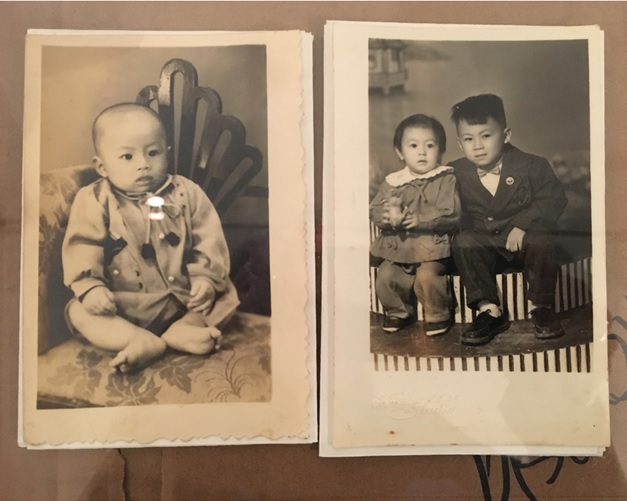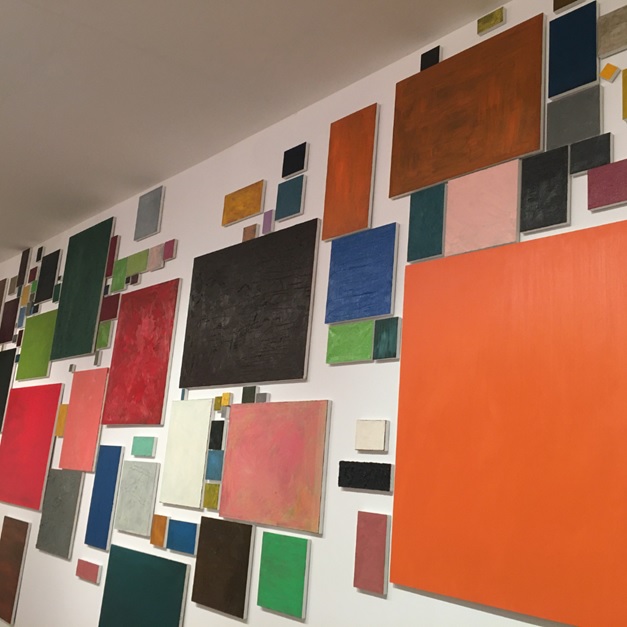We assign meanings to concepts ourselves. And we can change our perception of reality ourselves. But is it possible to reverse the meanings that have been attached to these specific terms in our consciousness for years? If it’s going to lead to something good, it’s worth at least trying.
From January 28th to March 11th at the Biała Gallery in Lublin you can see Wojciech Gilewicz’s exhibition “Walks on Trash”. I highly recommend this exhibition to anyone who would like to take such an unusual walk with the artist.
Nobody’s Memory, Shared Memory. A Collection of Photographs from Kaohsiung.
In the corner of the room is a stack of piled up cardboard boxes. Although closed, we guess they are empty. Who would stack full boxes this way? These are packages that have already been stripped of their contents. Photos were arranged on some. The featured collection of photographs is from Kaohsiung, in Southern Taiwan. On them are images from the lives of the unknown inhabitants of a country that Poland, like most countries, does not recognize as a separate nation.

These are recorded fragments of the history of several generations. These are intimate scenes of people’s lives – men, women, children. Portraits of infants, lumbering alone on beds, or cradled in their mothers’ arms. Reportage photos of travel, showing the World Trade Center towers, the Statue of Liberty, Mount Fuji.
Some of them are old photographs, black and white, in sepia, with characteristic serrations on the edges or with rounded corners (uncommon in Poland). According to the author, the found collection consists of more than 1800 photos, taken from 1930 to 2012, the year in which the owner of this collection, a wealthy and independent woman, died. The Kaohsiung collection was found by the artist among items discarded from a house being prepared for renovation by its new owner. Thanks to Gilewicz’s gesture, we can look into the family album of a stranger and reflect on the lives of the people depicted there.
Collections of a Mysterious Lady from Lublin and a Call to Action
Falowiec from Gdansk, drawings by Marcin Szancer, views of Lublin and many other representations can be seen on another of the presented collections. This is a collection of postcards from the 1960s. The owner of these cards, according to the artist, was “a mysterious lady from Lublin”. The find was excavated from the Warsaw garbage.

Wojciech Gilewicz not only shows the fragile border between what is valuable and what is unnecessary. He invites exhibition participants to give “new life” to unnecessary objects themselves. On the other side of the spacious room, items are spread out like antiques at a market stall. They come from the now non-existent family home of the artist in Biłgoraj. Everyday objects, trinkets, dishes, tablecloths, scales and other miscellaneous items. Anyone can take one under the condition that they take a picture of it in its new location and send it to the email address provided. The aim of the action, as the artist explains, is to change our consciousness – to give the concept of trash a positive meaning. In this way we replicate, as it were, Duchamp’s now historical gesture. We give objects a second life, we place them in a new context, and in this way we become their creators.

Art Camouflaged among Trash and Reusable Images
Going down to the lower floor, we see a photograph recording “Trash” – Gilewicz’s 2004 performance. Found in an illegal dump in Brooklyn, the artist used plates made of various materials as stretchers and painted them in the colors they had when he found them. He then placed in his natural environment. The paintings left there were gradually destroyed like other trash until the dump was cleaned up by the appropriate services. Art returns to its roots here. It performs mimetic functions. It imitates reality, it wants to become reality.

Another display consists of different sized and various colored stretchers. It’s a work in process that began in 2002. The artist invites everyone to co-create it. All you need to do is sign up for the suggested dates for the workshops accompanying the exhibition. On them you can repaint the image of your choice, thus giving it a new life. Some of the paintings already have dozens of layers of paint.

In the Name of No Waste and Circular Economy

Videos addressing the same theme are shown in the final exhibition rooms. An eye-catching video shows the artist first taking food out of the trash, then eating a meal made from what he managed to collect. Another video titled Trash Wolks captures images seen in New York City from 2018 to 2022. You can see on them the testimony of the huge waste, the overproduction of garbage. There are also examples of positive attitudes. Among them, trash diving – searching through trash for things to reuse, or freeganism – searching through trash for food that can be eaten. According to the artist, his action was intended to draw attention to the problem of littering the planet by people.

What constitutes our identity? Precious family photographs that sooner or later end up in the trash? Memory, or an attempt to save it? Or maybe the heaps of trash we produce are an equally powerful portrait of ourselves? Gilewicz’s exhibition forces us to reflect on many different issues that overlap and blur their boundaries
Text and photos: Dominika Szwed
English translation: Natalia Chojnowska
Polish version here
Do you like that report? You may also read:
Read: ‘A Song of Ice and Fire’ – the book series review
Read: Denis Villeneuve – Top Movies
Read: “How to Make Good Things Happen: Know Your Brain, Enhance Your Life” – Review

Znajdź ciekawe koncerty w naszej


 Dodaj wydarzenie
Dodaj wydarzenie Kalendarz
Kalendarz Moje konto
Moje konto


